Modelación productiva, económica y emisión de metano en sistemas de cría vacuna de Bahía Blanca y Coronel Rosales.
El objetivo de este estudio de simulación fue evaluar la respuesta productiva, económica y emisión de metano, y el valor marginal del agregado de alimento extra (VMA) en diferentes sistemas la cría vacuna de Bahía Blanca y Coronel Rosales. Se utilizó información regional y un modelo de simulación dinámico bioeconómico y ambiental (SIMUGAN) para evaluar cuatro planteos ganaderos basados en la incorporación tecnológica de pasturas perennes y prácticas de manejo como el tipo de destete: Tradicional (Trad), Transicional 1 (Trans1), Transicional 2 (Trans2) y Tecnificado (Tecn). El aumento en productividad se asoció positivamente con el margen bruto [MB($/ha)=-1488,6+30,2 x producción de carne kg/ha/año, R2 0,99] y con menor intensidad de emisión de metano [IMC(kgCH4CO2-e/kg peso vivo producido)=20,4-0,1x producción de carne, R2 0,98]. El VMA ($/KgMS/ha), en calidad de indicador sistémico de oportunidades de suplementación estratégica, fueron mayores en los planteos Trad y Trans1 que en Trans2 y Tecn. En líneas generales, los distintos planteos simulados presentaron un mayor VMA durante las estaciones de invierno y primavera por sobre la distribución anual de alimento extra. El presente análisis integral permitió identificar y cuantificar oportunidades de mejora en la productividad de estos sistemas incorporando pasturas permanentes.
Palabras claves: bovino carne, pastura, tecnología
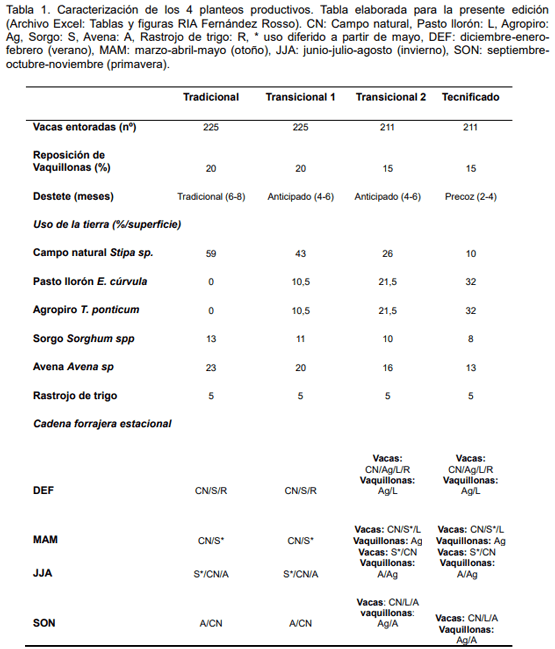
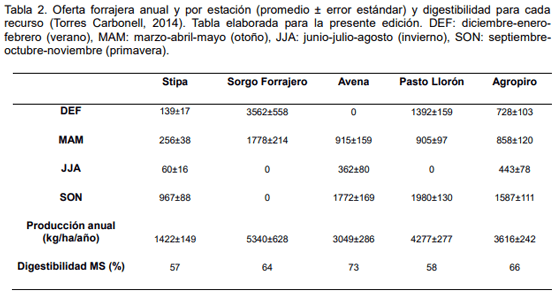
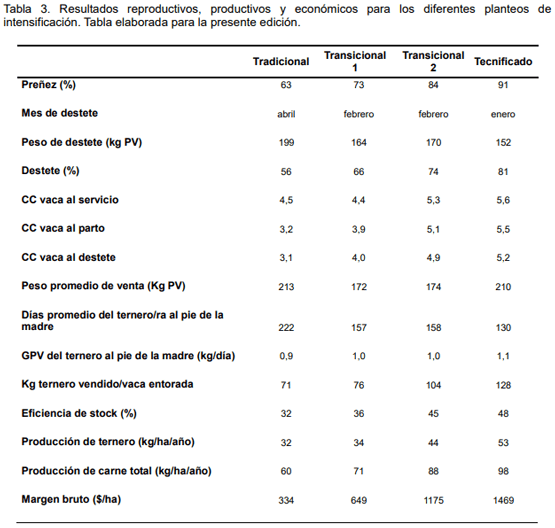
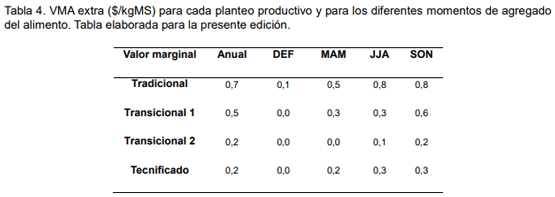
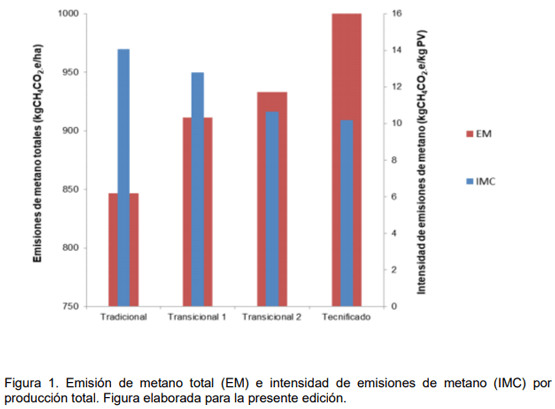
AACREA. 1990. Normas para Medir los Resultados Económicos en las Empresas Agropecuarias. Convenio AACREA - BANCO RIO. Buenos Aires. Argentina, 80 p. ARBOLAVE, M. R. 2017. Márgenes agropecuarios, Año 32-382(382), 80 pp.
ARROQUI, M.; ALVAREZ, J. R.; VAZQUEZ, H.; MACHADO, C.; MATEOS, C.; ZUNINO, A. 2015. JASAG: a gridification tool for agricultural simulation applications. Concurrency and Computation: Practice and Experience, 27(17), 4716–4740.
BÁRBARO, N.; GERE, J.; GRATTON, R.; RUBIO, R.; WILLIAMS, K. 2008. First measurements of methane emitted by grazing cattle of the Argentinean beef system. New Zealand Journal of Agricultural Research, 51(2), 209–219.
BELL, L. W.; ROBERTSON, M. J.; REVELL, D. K.; LILLEY, J. M.; MOORE, A. D. 2008. Approaches for assessing some attributes of feed-base systems in mixed farming enterprises. Australian Journal of Experimental Agriculture, 48, 789–798.
BERGER, H.; BILOTTO, F.; BELL, L. W.; MACHADO, C. F. 2017. Feedbase intervention in a cow-calf system in the flooding pampas of Argentina: 2. Estimation of the marginal value of additional feed. Agricultural Systems, 158(Supplement C), 68–77.
BEUKES, P. C.; GREGORINI, P.; ROMERA, A. J. 2011. Estimating greenhouse gas emissions from New Zealand dairy systems using a mechanistic whole farm model and inventory methodology. Animal Feed Science and Technology, 166–167, 708–720.
CROSSON, P.; SHALLOO, L.; O’BRIEN, D.; LANIGAN, G. J.; FOLEY, P. A.; BOLAND, T. M.; KENNY, D. A. 2011. A review of whole farm systems models of greenhouse gas emissions from beef and dairy cattle production systems. Animal Feed Science and Technology, 166, 29–45.
FAO; NEW ZEALAND AGRICULTURAL GREENHOUSE GAS RESEARCH CENTRE. 2017. Low-emissions development of the beef cattle sector in Argentina - Reducing enteric methane for food security and livelihoods. Rome. 39 p.
FAVERIN, C.; GRATTON, R.; MACHADO, C. F. 2014. Emisiones de gases de efecto invernadero en sistemas de producción de carne vacuna de base pastoril. Revisión bibliográfica. Revista Argentina de Producción Animal, 34(1), 1–22.
GARGANO, A. O.; ADÚRIZ, M. A. 2000. Modelos agropecuarios integrales para Bahía Blanca y Coronel Rosales, Argentina. Archivo Latinoamericano de Producción Animal, 8(1), 24– 33.
GARRIZ, C. A. 2012. Rendimientos, peso, composición de res y cortes vacunos en la argentina. Efectos del genotipo, edad y peso vivo de faena. ¿Producir carne con la raza criolla Argentina? Sitio Argentino de Producción Animal, 1–39.
GAUR, M. K.; SQUIRES, V. R. 2017. Climate Variability Impacts on Land Use and Livelihoods in Drylands. Springer. 348 p.
GERBER, P. J.; STEINFELD, H.; HENDERSON, B.; MOTTET, A.; OPIO, C.; DIJKMAN, J.; FALCUCCI, A.; TEMPIO, G. 2013. Tackling climate change through livestock - A global assessment of emissions and mitigation opportunities. Rome: Food and Agriculture Organization of the United Nations (FAO).
HERRERO, M.; HENDERSON, B.; HAVLÍK, P.; THORNTON, P. K.; CONANT, R. T.; SMITH, P.; WIRSENIUS, S.; HRISTOV, A. N., GERBER, P.; GILL, M.; BUTTERBACH-BAHL, K.; VALIN, H.; GARNETT, T.; STEHFETS, E. 2016. Greenhouse gas mitigation potentials in the livestock sector. Nature Climate Change, 6(5), 452-461.
INDEC. 2000. Censo Nacional Agropecuario 2002. Argentina (Buenos Aires: Instituto Nacional de Estadística y Censos).
INTA. 2000. Mapa de suelos de la provincia de Buenos Aires (1:50.000).
IPCC. 2006. IPCC guidelines for national greenhouse gas inventories. Inter- governmental. Panel on Climate Change, IGES, Japan.
KUNKLE, W. E.; SAND, R. S.; RAE, D. O. 1994. Effect of body condition on productivity in beef cattle. En FIELDS, M.J.; SAND, R. S. (Eds.). Factors affecting calf crop. CRC Press, Boca Raton, USA, pp. 167–176
LAURIC, A.; DE LEO, G.; TORRES CARBONELL, C. 2016. Sistemas productivos reales, incorporación de tecnologías estratégicas dentro de un marco de extensión y su impacto sobre los indicadores dentro de los Pdos. de Bahía Blanca y Cnel. Rosales. (https://inta.gob.ar/documentos/sistemas-productivos-reales-incorporacion-de-tecnologiasestrategicas-dentro-de-un-marco-de-extension-y-su-impacto-sobre-los-indicadoresdentro-de-los-pdos-de-bahia-blanca-y-cnel-rosales, verificado 02/06/2017).
LAURIC, A.; DE LEO, G.; TORRES CARBONELL, C.; FERNANDEZ ROSSO, C.; BILOTTO, F.; MACHADO, C. 2017. Perfiles productivos en los partidos de Bahía Blanca y Coronel Rosales. (https://inta.gob.ar/documentos/perfiles-productivos-en-los-partidos-de-bahiablanca-y-coronel-rosales, verificado 22/07/2017)
MACHADO, C. F.; BERGER, H. 2012. Uso de modelos de simulación para asistir decisiones en sistemas de producción de carne. Revista Argentina de Producción Animal, 32, 87– 105.
MACHADO, C. F.; BERGER, H.; MORRIS, S. T.; HODGSON, J. 2008. Evaluation of a beef cattle finishing simulation model for intake and live weight gain prediction under different herbage and maize grain allowances. Proceedings of the International Grasslands Conference, China, 324.
MACHADO, C. F.; MORRIS, S. T.; HODGSON, J.; ARROQUI, M. A.; MANGUDO, P. A. 2010. A web-based model for simulating whole-farm beef cattle systems. Computer and Electronics in Agriculture, 74(1), 129–136.
MCEVOY, M.; O’DONOVAN, M.; SHALLOO, L. 2011. Development and application of an economic ranking index for perennial ryegrass cultivars. Journal of Dairy Science, 94(3), 1627–1639.
MENGISTU, A. 2006. Country Pasture/Forage Resource Profiles. Rome, Italy. FAO. MINAGRO. 2015. Caracterización de la producción bovina. Buenos Aires – Corrientes – Chaco – Formosa – La Pampa– Misiones. Sistema de Monitoreo del Sector de la Carne Bovina. Serie 1. Presidencia de la Nación, Subsecretaria de Ganadería, 193 pp.
MOORE, A. D.; ECKARD, R. J.; THORBURN, P. J.; GRACE, P. R.; WANG, E.; CHEN, D. 2014. Mathematical modeling for improved greenhouse gas balances, agro-ecosystems, and policy development: lessons from the Australian experience. Wiley Interdisciplinary Reviews: Climate Change, 5(6), 735–752.
PICASSO, V. D.; MODERNEL, P. D.; BECOÑA, G.; SALVO, L.; GUTIÉRREZ, L.; ASTIGARRAGA, L. 2014. Sustainability of meat production beyond carbon footprint: a synthesis of case studies from grazing systems in Uruguay. Meat Science, 98(3), 346– 354.
REARTE, D. H.; PORDOMINGO, A. J. 2014. The relevance of methane emissions from beef production and the challenges of the Argentinean beef production platform. Meat Science, 98(3), 355–360.
SAYDS. 2015. Tercera Comunicación Nacional de la República Argentina a la Convención Marco de las Naciones Unidas sobre Cambio Climático, 282 p.
SPITZER, J. C.; MORRISON, D. G.; WETTEMAN, R. P.; FAULKNER, L. C. 1995. Reproductive responses and calf birth and weaning weights as affected by body condition at parturition and postpartum weight gain in primiparous beef cows. Journal Animal Science, 73, 1251– 1257.
TORRES CARBONELL, C. 2014. Impacto del cambio climático global sobre las precipitaciones del Sudoeste bonaerense semiárido y su efecto sobre el riesgo de sistemas ganaderos con distinto grado de adopción de tecnología. Tesis Doctorado en Agronomia, 225 p.
TORRES CARBONELL, C.; MARINISSEN, A.; LAURIC, A. 2013. Desarrollo de sistemas de producción para la Ecoregión Semiárida Pampeana Sur. INTA, 17 p.
WILSON, G. A. 2008. From “weak” to “strong” multifunctionality: Conceptualising farm-level multifunctional transitional pathways. Journal of Rural Studies, 24(3), 367–383.









